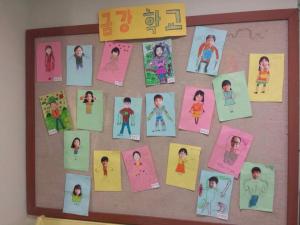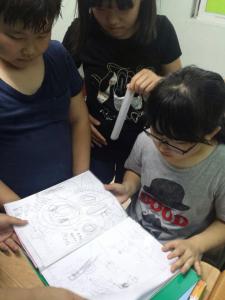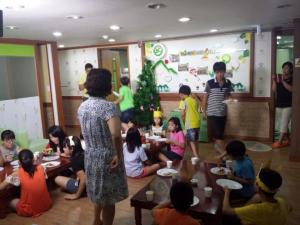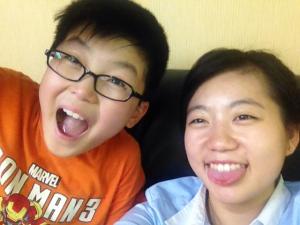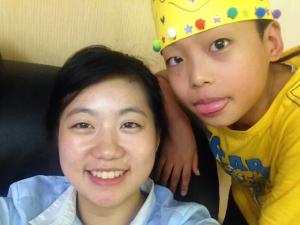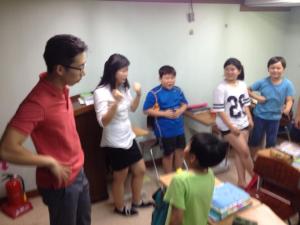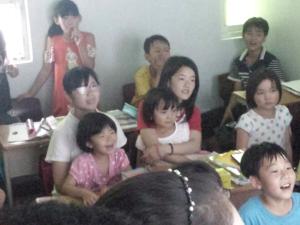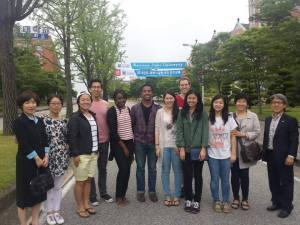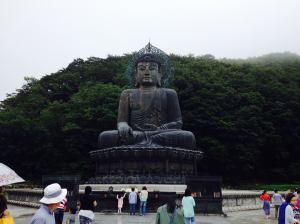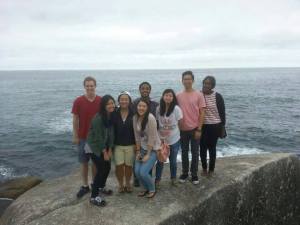We said goodbye to our first few days of freedom that we had in simply exploring our new home for the summer, and we also said goodbye to our fascinating journey to Seoul’s Ministry of Unification and the DMZ. It was our first week at Kumgang School (금강 학교) our purpose for traveling to Seoul in the first place. We would no longer be explorers, but residents. No longer passive learners, but active participants.
The only taste of the school we had gotten was a very brief visit to the school we had made the day before (we’re talking ten minutes), where we got to simply look at the campus, greet the principal, and see a group of smiling kids standing in the large room they had to do activities in.
On the first morning, we took the subway early just for precaution, going from Hongdae Station across the Han River to Shindorim Station, transferring to another line and finally ending up at Gaebong Station. By this time we were already accustomed to the subway, so we didn’t end up making fools of ourselves by falling or swaying due to the speed. Dressed up in business casual style, we rode clustered together, anticipating how our first day plans would turn out.
When we arrived at the school, we met one of the teachers at the school, Ms. Ko (Ko seonsaengnim) for the first forty-minute period of the day in order to get better acquainted with the school’s operation before we met the students and in order to ask some of the pressing questions we had. How were we to address them? Were we to use chondetmal (formal language) or panmal (informal language)? What exactly was she and the other people who run the school exactly expecting of us during this seven-week engagement? Ms. Ko let us know that we could speak to the kids informally and address them by their given names. She also said that first things first, we should help the kids with the homework they brought from their regular South Korean public schools, and after that, focus quite a bit on English, Math, and when possible Korean (especially for the kids who know more Chinese than Korean). We took all of this in, and a handful of the group got ready to work with the kids who stay at the school in the morning.
There were only two students at Kumgang in the morning, though there were usually four who stayed back at the school so that they could catch up in learning Korean so that they could soon join regular Korean public schools. As we were told earlier in the year, most of these North Korean refugees have come to South Korea by route of China, so many of them have spent the majority of their lives in China, speaking Chinese the most fluently and sometimes even feeling nationally Chinese rather than Korean. Since Michelle speaks Chinese fluently and I can get by in conversational Chinese, we both went into the reading room where two Chinese-speaking boys, one eleven years old and the other, fourteen, were sitting expectantly. Jina also accompanied us, and later as did most of the other DESKalators (a self-chosen denomyn for those in Duke Engage South Korea). We mainly worked on Korean passages with the boys, and so we were equally dependent on the Korean-speaking DESKalators for understanding the material and on the Chinese speakers for conveying the information to them so they’d understand. It was not easy material for the students, and it wasn’t easy material to teach either. I hope that we were an encouraging force for them though, able to make them excited about learning new things (or even the same things but with a different language-paradigm). Since these students are now residents of South Korea, and by some strange twist of fate, China can no longer be their country and they must adopt this new one and become familiar with its ways. I’m never against encouraging foreign languages, but it does seem quite a pity that foreign language learning for countless refugees and migrants around the world has to come in the context of being thrown into the unfamiliar and having to unlearn what they’ve already spent their lives learning and making progress in. I hope that these students all learn to love the Korean language for its beauty, complex and simple, as well as the peninsula that language is spoken in, and I will do by best to speak to them in Korean when possible. But of course, it is priceless to see little eyes widen in wonder and joy when they learn that some of their new teachers can converse with them in their heart language.
After working in a very individual-focused manner until around 2:30, the rest of the kids at Kumgang came back from their public schools, and for the rest of the day, it was, to be quite frank, chaotic. The students, I’m sure, were wary of us as outsiders coming in to volunteer for the summer (as many have already experienced South Korean and American students coming in to volunteer before), but they were also very excited to meet us, and we DESKalators were more than excited to meet all of them. In that first period, we did an ice breaker game in the large upstairs room, which was certainly a way for the kids to channel their abundant energy. In the game, everyone made a circle and someone had to say “I love [something],” and if other people in the circle love that something, they had to switch places, and whoever didn’t have a pair of shoes to stand in front of had to go next and say something they love.
I think the energy levels were certainly a surprise for most of us. Some kids would slam the door and say “Merong” (a kind of “nanny nanny boo boo”), run and yell, and on the other hand, some would choose not to participate in activities. There were also a lot of violent tendencies that we noted: hair-pulling, casual pretending to choke each other, and sometimes slapping. We wonder how much of their past trauma in the family realm and in the realm of international migration has affection their lives today – their mood, outlook, levels of trust with certain people, and their need for attention. Kumgang is essentially a boarding school, and while majority of the kids seemingly get to see their parents on the weekend, some of the kids rarely have the opportunity to see their parents (some only get to see them two days out of the year). Learning facts like this is tough, but it also puts things into perspective when it comes to dealing with behavioral issues and giving them the attention that they need and deserve. Throughout the days, we also wondered what exactly was the purpose of our volunteering at the school. Is learning material like English and Math really the big take-away for these kids this summer? It would definitely be great if the students were able to have a portfolio or a project to explore their identities and their dreams, and I’m sure that would be a great thing, created by the students themselves, to leave behind But maybe the attention we give them during the school week will be equally important.
Some things about us as the teachers, though, inevitably threw up some barriers. First and foremost, language greatly affected our interactions with the kids. Only two of us speak Chinese, and most of us speak Korean on a very wide spectrum of ability. But honestly, a lot of the time, speaking feels like bumbling around, especially for me. I’m trying my best to communicate, but sometimes the language ability barrier makes me sound awkward and unconfident – something I will have to improve on through the weeks, and which I am sure will naturally get better by just interacting with the students every day.
Secondly, for many students, people of different races was a huge novelty. For example, when Anna walked into one classroom, one boy asked her if she had eaten too much chocolate, and if that was why her skin looked different. A lot of the students are also very eager to feel my arm hair and ask if my legs look the same (since white people tend to have more body hair…). All of the students are really sweet and are very accepting of us, however, despite some differences. I think that it’s an exciting experience for them, but it’s equally exciting for us teachers to learn from all of the kids, who vary a lot in personality, age, language, interests, and more.
A difficulty we encountered on this first day was that it seemed that none of the kids had any homework that they had brought from their public Korean schools. As well, many of the kids different greatly in level, and we found out that age does not necessarily correspond with grade level. We would have to come up with ways to engage everybody’s interest and learning while also catering to different levels. A balancing act between group learning and one-on-one help would be necessary.
Overall, the second day went much more smoothly than the first. We were starting to remember a majority of the students’ names, and we were much more confident in what we were to expect from the school day. We had prepared concrete lessons and worksheets for the students, and we found that doling out very specific assignments was a great way to keep the students engaged, diligent, and free from rowdiness. However, we also started to learn that balancing the more fun subjects with the harder, not as dynamic ones was important for keeping the students engaged and channeling their energy when it started to show up more.
We also learned that the students are in love with certain K-pop groups (*cough* EXO *cough*) as well as American animation (*cough* Frozen *cough*), so engaging them in their own interests, we found, was crucial. We had a great time teaching some of the English lyrics to “Let it Go” from Frozen, and letting them partake in creative assignments such as one in which they were able to create and draw their very own animal and tell the class about where it lives, what it eats, and why they wanted to create it. However, the week at Kumgang teaching and getting to know these students has definitely shown the flaws of the glitzy world of Hallyu (the Korean pop culture wave) in not being representative with the reality of Korea’s people of diverse backgrounds. While fun to engage in music and culture, it is always a good idea to question what kind of image of Korea it props up and what type of Korean person it promotes (in terms of beauty, wealth, ethnicity, language, and so on). I am beyond excited to keep on moving throughout the weeks here in Seoul, on the streets and in the school. I know that there are great plans ahead of us, even if they are foggy at the moment, and we DESKalators will do our best to carpe the diem and live haru-haru (day by day).
Similar to Tuesday, we only taught in the afternoon on Wednesday. We used the same teaching strategies from the day before and tried to plan a lesson or an activity for each period while separating into two smaller classes. Even though the kids were willing to participate and pay attention on Tuesday, they were oddly in a bad mood on Wednesday. It seemed as though that if one of them was in a bad mood, it brought down the mood of all the other kids in the class. This really heightened their slightly violent behavior and most of them had a harder time focusing and staying motivated to learn. A lot of the kids tried to either leave or sleep instead of participating in class. We were a bit confused and unsure about the source of this mood swing, but we suspect that a lot of this is because they are not allowed to leave the school during most of the day. Furthermore, we made the grand mistake of having the two classes play at different times. When one class was playing, the other class that was having a lesson was chaotic because the kids were complaining that they did not get to play as well. We definitely learned it the hard way that playtime should be at the same time for both classes.
We faced another obstacle later in the day when the principal brought in two new students who cannot speak a word of Korean. We were quite unprepared because we were never told about these new students, but we handled the situation with grace by separating one of the classes into two smaller classes and having one class that focused on learning Korean for these Chinese-speaking students. We quickly got a sense of their skill levels and made worksheets for them on the spot for them to start learning with the other students.
It was pretty clear during the past couple days that communication with the principal was lacking and inefficient. In order to solve this problem, a couple of us went to speak to her about our concerns regarding this issue. Even though we expected some positive responses, we were disappointed by her reaction. It was clear that they had numerous administrative difficulties, confusion about details, lack of knowledge about the kids. But despite this incident, we continued to remain professional and positive towards our relation with them, because in the end, we are here for the kids.
Besides a couple difficulties throughout the day, it was definitely clear that we were all improving in controlling the kids in the class, teaching the classes, and handling unexpected situations. The kids also seemed to be growing fonder of all of us. There was definitely a gap between the kids and us on the first day of teaching, but the kids were now hanging on our arms, playing with our hair, and giving us drawings of us. Even though it was only our third day with the kids, it was amazing how much we were able to reach out to them.
For Thursday, our last teaching day of the week, Professor Kim joined us! It was initially very confusing because we thought that we would only be teaching the Chinese-speaking kids in the morning and the regular class in the afternoon, we found out that all the kids were going to be in the school all day. We split up the morning into two classes where a group of us taught the Chinese-speaking kids Korean and the other kids played together and worked on the computer. For the Chinese-speaking kids, we focused on more one-on-one time for personal attention and help, which we found to be very valuable. The kids not only were more open to learning, but also were able to focus better. In the afternoon, we had regular lessons like we did before. The kids seemed to be a lot better about paying attention, maybe because they were able to release a lot of their energy by playing in the morning. We tried to teach them English by singing “Let It Go” from Frozen. The class was quite successful! The kids really loved it and were mostly willing to participate. Through this class, the kids opened up more even more to us and some were even sad that we were not going to be coming on Friday.
We started our Friday with a North Korean food workshop. We learned how to make potato dumplings (감자 만두) and tofu rice (두부밥). Potato dumplings are famous in 함경도, a region in North Korea while tofu rice is a traditional food, in some ways North Korean version of South Korea’s 떡볶이. We had the chance to learn about the foods, learn how to make them, and even make it ourselves! After our food workshop, we headed to 인사동where we walked around and explored the streets. Next, we went to 남산타워 by taking a cable car to the top of the mountain. We were able to see the locks that people put on the fences and saw beautiful night lights once the sun set. It was a busy and a tiring day, but a valuable experience filled with exciting events where we were able to learn more about the Korean culture.
